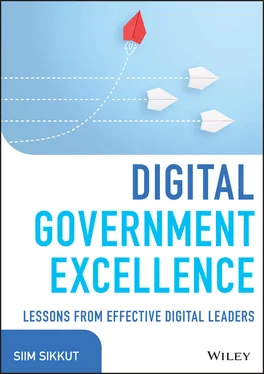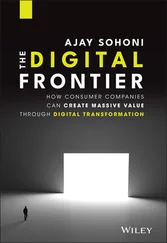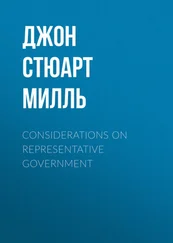LC ebook record available at https://lccn.loc.gov/2022000946
Cover Design: Wiley
Cover Image: © phototechno/Getty Images
To all the digital government doers—wherever and whoever you are
Digital government is an increasingly hot topic around the world. That is why there is a growing body of knowledge and a growing circle of consultants helping governments to develop their digital strategies as well as put in place the governance mechanisms for its delivery.
As we have seen so many times in so many places around the world, good plans and even right institutions alone do not cut it—if the right teams and, especially, the right leaders are not there to make the most of them. Still, surprisingly little know-how has been available about the good practices and insights on how to practically lead governments to next levels of digital transformation successfully.
I have had the luck and privilege of meeting many excellent digital government leaders as colleagues and peers along my own professional journey of leading this field in Estonia, a country with more than twenty years of digital government track record to show. Each time we have had a chance to properly sit down and talk eye-to-eye, we eagerly pick each other's brains and ask for advice or for each other's practical methods on how to lead our government's digital change the best way.
This book was born from the desire to bring such candid, peer-to-peer conversations to a wider audience. There simply are many, many more of us, the digital government doers who could hopefully benefit from these insights. If it helps to advance the digital services and governance anywhere in the world a tiny bit, it already has served its purpose.
In this book you have conversations with twenty remarkable digital government leaders from around the world, each sharing their journey and lessons in their own words. It was a pure delight to have these chats with them; I myself learned from each one even if I have known the person for a long time.
I hope you will find their lessons valuable, too. If you even get only one idea for your work from each chapter, you will have at least twenty tried-and-tested good ideas to add to your own practice or suggest to your clients by the time you finish this book.
This book would not have been possible without the twenty remarkable digital government leaders who are featured here with interviews. They all agreed to be included as soon as I asked, which is a great honor. They all contributed exactly what I knew they would: their leadership wisdom through practical insights, their hard lessons, and their happy learnings. They also patiently went through the pains of reviewing the transcripts. Thank you for being my peers, and my friends! I keep learning from you, even if you may not be in government anymore.
Barbara Ubaldi from OECD, David Eaves from Harvard Kennedy School, Linnar Viik, and my brother-in-arms Kristo Vaher, Estonian government's Chief Technology Officer, were instrumental in encouraging me to move the book from idea to proposal by sparring with me on the concept and content plan at inception of the idea.
More than thirty experts and practitioners from the field of digital government from all over the world were helpful contributors to the small early snowballing exercise I conducted before the book proposal submission, helping to shape the substance for the interviews and the list of interviewees. There are so many of you to name but you know who you are! Your encouraging answers also confirmed that this book would be a good idea.
Sheck Cho, executive editor at Wiley, was brave and kind to pick up my initial LinkedIn ping, had faith to sign me on, and in the most effective manner guided me through to the initial book preparation. Susan Cerra, managing editor, was most kind in steering me until the end and allowing for some pushback of deadlines beyond the initial schedule. Thanks also to everyone else at Wiley, who put time and effort for this title to come together in the most professional and easiest way through editing, proofing, typesetting, publishing, promotion, and beyond.
I have been lucky to have an extraordinary team come to work with me at the Government CIO Office of Estonia and allow me to be your lead. You have helped me grow and educated me on-the-job; you have made all our successes happen. The chance of working with you and the challenges we have jointly addressed were exactly what pushed me to wonder what the good practices are out there, and how some of the best in our game have dealt with the same issues.
Finally, I do have to thank my wife, Riina, for making it possible for me to take the time and space to get this book together even as we have three kids running around at home and there are day jobs to be done, too. Love you and our girls!
Whenever government CIOs or colleagues with similar titles and responsibilities meet, be it within a country or at an international level, it is like a support group meeting of sorts. We listen to each other's challenges and trials; we bounce ideas off each other about how to solve them and share practical insights on what we have tried ourselves for it. We lean on each other to hear if anything has worked well or not—and then perhaps copy that practice.
This is natural, because peer-to-peer sharing and learning are one of the most valuable ways to learn. At the end of the day, our jobs and, therefore, the joys and troubles are very similar country to country or organization to organization.
There is a growing number of international and other groupings, annual events, and chat channels for peer learning in the digital government space. One of the reasons is that the good practices and country examples are still too seldom codified and mostly spread through word-of-mouth only. Too often, these conversations and learnings stay just between people and closed doors, or direct chat channels.
However, digital government is a growing phenomenon and movement all over the world, in latest part because of COVID-19 pandemic's (one good) impact. There is a growing eagerness around the world to digitally transform governments—to take the public services and governance to a digital era, finally. Yet, actual success and achievement in building out a digital government greatly varies among countries as well as within them, with many failed or stalled attempts.
Thus, there is a growing demand to learn how to really build a digital government that works well. That is why there should be value and interest for the sharing of the relevant leadership or management lessons more widely.
And that is why the idea for this book was born. As a digital government leader myself until recently, I always yearned to hear from peers how they did what they did, how were they solving some strategy or management or other issue that I encountered in my work.
In my ten years in this business, I have had the good fortune to meet literally hundreds of digital leaders from all kinds of geographic, sectoral, and digital maturity backgrounds. Each time I picked their brains and their practical experience drawers for tips and tricks. That is what got me thinking—could we somehow make these nuts of insights available more widely?
In a way, there already exists a lot of research and writing on how governments have, can, and should build up a digital government. You can easily find cases and guidelines on what should be the strategy and the policies to make the most of digital technology for improving public services and policy delivery. Such literature covers either or both the theoretical models as well as practical case study angles. A range of international institutions and all kinds of consultancies work daily to compile and disseminate these kinds of findings and know-how.
Читать дальше












